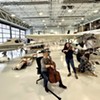Published September 10, 2003 at 4:00 a.m.
I am so nervous I can't manage a deep breath. With 19 other couples, we stand in the dimness of the staging area waiting for the announcer to invite us onto the dazzlingly bright, cavernous competition dance floor. There, five international judges will decide if we deserve to become one of the six couples in the final heat.
My partner David Larson and I are in St. Paul, Minnesota, at the U.S. National Ballroom Championships with our coach Bobbi Davies and four other couples from the Vermont DanceSport Academy (VDA). We're here to compete with 600 participants for awards in standard and Latin events (see sidebar). The best will become national champions, and some of them will represent the U.S. at the upcoming World Championships.
In the hierarchy of Bronze, Silver and Gold, David and I are rated Bronze level, and we definitely feel like babies. But in St. Paul, Bobbi has entered us in the Silver category for some dances to give us more experience at competition -- or to scare us to death.
Costumes are allowed in Silver but not in Bronze, so, without time to change, we are the dowdy pair among a flock of exotic birds in feathers, sequins and floor-length gowns. David looks like a waiter in his starched white shirt with bow tie. Dressed all in black, my hair helmeted with "Instant Freeze" hairspray, I look more like I'm attending a funeral than a dance. But after months of classes, coaching, drills, qualifying events and practice, only two thoughts are in my head as we move into the light to perform the waltz: Keep your feet on the floor and keep breathing.
Ten seconds after our music begins, David and I are boxed in and run over three times by dancers who should know better. We are doing a basic waltz pattern that restricts us to the outer perimeter of the floor, almost nose-to-nose with judges who nonchalantly click off scores as they scan the room. Think "Survivor" is ruthless? Here you have seconds to make an impression and not be voted off.
The rest of the group -- the real Silvers -- do advanced patterns that carom around the space. By the time we extricate ourselves the scoring is over. When we do our ending curtsy/bow, our initial fear is replaced by a feisty determination not to get bullied in tango, our next dance. (Each competition event is made up of two to five dances, and scoring is based on individual dances as well as on the event as a whole).
Tango is a dramatic dance. Couples stalk like crouching tigers across the floor, punctuated by sharp direction shifts. When tango becomes competitive, it is like a jungle out there. David and I focus on not getting run off the floor.
Our performance has improved after our third dance, the foxtrot, and three judges decide we're good enough for the Silver semi-final. We end up ranked 12th, not high enough to return but with enough encouragement from the judges to hang onto our dance shoes. By the time we dance our Bronze-level waltz and foxtrot, where we finish fifth, we feel like old pros. We even manage to have fun at the afternoon Latin dances, where we earn our best scores of the day for rumba and cha-cha. Later in the evening, we watch top-level Latin dancers burn up the floor with moves that are so stunningly sensual it's hard to believe they're legal.
Ballroom dancing is growing in popularity; it was even accepted by the International Olympic Committee as a non-medal sport -- technically, the name is "dancesport." Some dance contingents, like those from California and New York, are huge, arriving at competitions en masse in matching warm-up suits and silky jackets emblazoned with studio names. Our Vermont group decides we definitely need T-shirts next year. Seeing us, one participant raises an eyebrow and says, "I didn't know they even had ballroom dancing in Vermont."
In fact, Vermont has its share of champions. David and Paula Schneider of Burlington are senior U.S. Latin champions. Bill and Carolyn Pedrick have Silver and Gold medals in both standard and Latin; and David Schneider (no relation to the other one) and Agnes Liem brought home a Bronze in standard. Joe LaRose and Meg Pedrick compete at the British Open in Blackpool, England -- basically the World Series of ballroom.
These award-winners have all had to overcome the obstacles of trying to dance competitively in Vermont. We lack elements that are common in urban areas -- like a ballroom, for example. Denied access to the University of Vermont dance studio and the gym at the former Trinity College -- which Bobbi renovated as a ballroom before the campus was sold -- we go begging for facilities large enough to practice a long line of dance. David Larson once resorted to shoving potted plants aside and practicing promenade in the Burlington Town Center next to Filene's.
We also train without seeing other competition-level dancers. While social dancing thrives here, there's a huge difference between a Saturday-night get together and the kind of polish demanded at national and international competitions.
Finding the right instructor can be confusing when there are no criteria for calling oneself a dance teacher and even a certification is no guarantee of quality. (My advice to new students? Attend a dance and ask the dancers you enjoy watching where they study). A fortunate fluke brought Bobbi Davies, a world-class coach, to the area. She competed at the national and world levels, owned the School of Ballroom Dance in Manhattan and taught competitive dancers for nearly 40 years before "retiring" and establishing the Vermont DanceSport Academy, now located in Williston.
Bill and Carolyn Pedrick have studied with Bobbi for six years, traveling from Northfield for lessons and drills; gasoline is a major line item in their budget. After enjoying social dances for years, the couple felt they'd hit a plateau. "We wanted to improve as dancers," says Carolyn. "We knew there was more and we set out to find it. What we found was a whole new set of goals and opportunities." The Pedricks also "found" dozens of awards and medals in the U.S. and Canada.
David Schneider started his dancing career when he turned 60. He and wife Paula are now senior national champions. "Over the years, we've done everything wrong you can possibly do," she admits. "We've danced off-rhythm; David once walked away in the middle of my ending curtsy; we've stopped and started again; but the quality of the technique that Bobbi teaches rises to the top, and the judges recognize that."
Indeed, the precision Bobbi demands can be challenging. David Larson is an established instructor, a UVM dance faculty member and a former national champion through the Fred Astaire Studio system, but he needed to unlearn much of his American-style training in order to start over at the VDA. When I began lessons after a lifetime in modern dance and experience as a swing and salsa instructor, I spent months re-learning how to walk. My previous training taught me to use the floor to get up in the air. In ballroom, I had to learn how to keep my feet in contact with the floor as much as possible.
I also needed to learn a new kind of balance. In salsa and American-style ballroom, which includes swing, dancers work in open positions, and one wobble isn't going to bring the partnership to a crashing halt. With international ballroom dancing, once dancers enter a closed dance position together, they do not leave it. The position resembles a martini glass, with bellies in constant contact and the upper part of the body reaching higher than you might think humanly possible.
The balance of the couple, not the individual, is paramount. It is frustrating, difficult and elusive, but once it's achieved, dancing takes flight. At our competition in St. Paul, we see championship-level dancers accomplish this. In the foxtrot they look like they're on ice skates; the breeze left in the wake of their quicksteps sends event programs flying. And they seem to defy gravity as ladies in fluttery, feathery gowns and gentlemen in tuxedoes hover a long moment before igniting the waltz.
Throughout the competition, after each VDA couple dances, we rush over to Bobbi like chicks to a hen for advice on the next round. She doesn't mince words. "Well, at least I knew what figure you were doing." "Good. Now go back and do it again." "What in the world were you doing out there?" Armed with specifics -- "Don't break your wrist in the tango next time" -- we have at it again. We try to win finalist ribbons, perhaps even medals, but mostly we try to dance the way Bobbi has taught us.
In St. Paul, all events lead up to the weekend highlight: the International Standard Champion-ship. As a treat for the audience, the announcer invites all 60 couples onto the floor for waltz. VDA teammates Joe LaRose and Meg Pedrick are among them, and we cheer until we're hoarse. We may not have team jackets or a real ballroom to practice in, but when the announcer says, "Ladies and gentlemen, these are the best dancers in the United States," we cheer for something we do have: ballroom dancing, even in Vermont.
As part of National Ballroom Dance Week, Sept. 19-28, Rebecca Brookes, David Larson and other area instructors offer free classes to anyone wanting to give ballroom, Latin, salsa and swing dancing a try. Info, 864-7953. For details about National Ballroom events in Vermont, call Timna Dulmer at 864-9301 or visit http://www.geocities.com/usabda-vt.
Speaking of Dance,
-

Seniors Dance With Joy at St. Johnsbury's Quahog Dance Theatre
Jan 17, 2024 -

Soundbites: Soundbites: DJ Malcolm Miller's Second Act
Dec 13, 2023 -

Middlebury Choreographer Christal Brown's 'What We Ask of Flesh' Explores the Burdens We Carry in Our Bodies
Nov 1, 2023 -

A Dance Theater Work Foregrounds Climate Crisis at WRJ Fest
Jul 12, 2023 -

New Works by Paula Higa Dance Explore Themes of Migration and Identity
May 3, 2023 - More »
Comments
Comments are closed.
From 2014-2020, Seven Days allowed readers to comment on all stories posted on our website. While we've appreciated the suggestions and insights, right now Seven Days is prioritizing our core mission — producing high-quality, responsible local journalism — over moderating online debates between readers.
To criticize, correct or praise our reporting, please send us a letter to the editor or send us a tip. We’ll check it out and report the results.
Online comments may return when we have better tech tools for managing them. Thanks for reading.










































